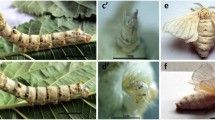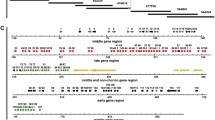Abstract
A partial genomic clone of Bombyx mori homologue of the segment polarity gene Cubitus interruptus (BmCi), encoding the conserved zinc finger domain and harbouring two introns, has been characterized. BmCi was expressed in the silkglands of B. mori from embryonic to the late larval stages(3rd, 4th and 5th intermoults). The expression was confined to the anterior region of the middle silkglands, overlapping with the domain of sericin-2 expression and excluding the domains of Bm invected expression, namely the middle and posterior regions of the middle silkglands. In the wing discs, the expression was restricted to the anterior compartment, which increased from 4th to 5th larval intermoults and declined later in the pupal wing buds. In gonadal tissues (both ovaries and testes) BmCi was expressed from the larval to pupal stages. The transcripts were localized to the sperm tubes containing spermatogonia in the testis of Bombyx larvae. BmCi expression, however, was not detected in any of these tissues during the moulting stages. Expression of Ci in the wing discs and gonads is evolutionarily conserved, while the silkgland represents a novel domain. Our results imply that BmCi is involved in the specification and maintenance of micro-compartment identity within the middle silkglands.







Similar content being viewed by others
References
Ahmed A, Podemski L (1997) Use of ordered deletions in genome sequencing. Gene 197:367–373
Alexandre C, Jacinto A, Ingham PW (1996) Transcriptional activation of hedgehog target genes in Drosophila is mediated directly by the Cubitus interruptus protein, a member of the GLI family of zinc finger DNA-binding proteins. Genes Dev 10:2003–2013
Amanai K, Suzuki Y, Ohtaki T (1994) Involvement of a maternally transcribed lectin gene in the early developemnt of Bombyx mori. Roux Arch Dev Biol 203:397–401
Aza-Blanc P, Ramirez-Weber FA, Laget MP, Schwartz C, Kornberg TB (1997) Proteolysis that is inhibited by hedgehog targets Cubitus interruptus protein to the nucleus and converts it to a repressor. Cell 89:1043–1053
Bailey EC, Scott MP, Johnson RL (2000) Hedgehog signaling in animal development and human disease. Ernst Schering Res Found Workshop 29:211–235
Bello B, Couble P (1990) Specific expression of a silk-encoding gene of Bombyx in the anterior salivary gland of Drosophila. Nature 346:480–482
Bello B, Horard B, Couble P (1994) The selective expression of silk-protein-encoding genes in Bombyx mori silk gland. Bull Inst Pasteur 92:81–100
Chomczynski P, Sacchi N (1987) Single-step method of RNA isolation by acid guanidinium isothiocyanate-phenol-chloroform extraction. Anal Biochem 162:156–169
Chen EH, Baker BS (1997) Compartmental organization of the Drosophila genital imaginal discs. Development 124:205–218
Couble P, Prudhomme J-C (2002) Perspectives in silkworm (Bombyx mori) transgenesis. Curr Sci 83:432–438
Couble P, Michaille J-J, Garel A, Couble M-L, Prudhomme J-C (1987) Developmental switches of sericin mRNA splicing in individual cells of Bombyx mori silkglands. Dev Biol 124:431–440
Dang DT, Pevsner J, Yang VW (2000) The biology of the mamalian Kruppel-like family of transcription factors. Int J Biochem Cell Biol 32:1103–1121
Dhawan S, Gopinathan KP (2002) Molecular cloning and expression pattern of a Cubitus interruptus homologue from the mulberry silkworm Bombyx mori. Mech Dev 118:203–207
Echelard Y, Epstein DJ, St-Jaques B, Shen L, Mohler J, McMahon JA, McMahon AP (1993) Sonic hedgehog, a member of a family of putative signaling molecules, is implicated in the regulation of CNS polarity. Cell 75:1417–1430
Hodgkin J (1983) Two types of sex-determination in a nematode. Nature 304:267–268
Hodgkin J (1987) A genetic analysis of the sex-determining gene, tra-1, in the nematode Caenorhabditis elegans. Genes Dev 1:731–745
Holland PW, Williams NA, Lanfear J (1991) Cloning of segment polarity gene homologues from the unsegmented brachiopod Terebratulina retusa (Linnaeus). FEBS Lett 291:211–213
Hui CC, Matsuno K, Ueno K, Suzuki Y (1992) Molecular characterization and silkgland expression pattern of Bombyx engrailed and invected genes. Proc Natl Acad Sci USA 89:167-171
Hui CC, Slusarki D, Platt KA, Holmgren R, Joyner AL (1994) Expression of three mouse homologs of the Drosophila segment polarity gene Cubitus interruptus, Gli, Gli-2 and Gli-3, in ectoderm- and mesoderm-derived tissues suggests multiple roles during postimplantation development. Dev Biol 162:402–413
Kango-Singh M, Singh A, Gopinathan KP (2001) The wings of Bombyx mori develop from larval discs exhibiting an early differentiated state: a preliminary report. J Biosci 26:167–177
Keys DN, Lewis DL, Selegue JE, Pearson, BJ, Goodrich LV, Johnson RL, Gates J, Scott MP, Carroll SB (1999) Recruitment of a hedgehog regulatory circuit in butterfly eye-spot evolution. Science 283:532–534
Kinzler KW, Binger SH, Bigner DD, Trent JM, Law ML, O'Brien SJ, Wong AJ, Vogelstein B (1987) Identification of an amplified, highly expressed gene in a human glioma. Science 236:70–73
Kinzler KW, Ruppert JM, Bigner SH, Vogelstein B (1988) The GLI gene is a member of the Kruppel family of zinc finger proteins. Nature 332:371–374
Kokubo H, Takiya S, Mach V, Suzuki Y (1996) Spatial and temporal expression pattern of Bombyx fork head/ SGF-1 gene in embryogenesis. Dev Genes Evol 206:80–85
Liu CZ, Yang JT, Yoon JW, Villavicencio E, Pfendler K, Walterhouse D, Iannaccone P (1998) Characterization of the promoter region and genomic organization of GLI, a member of the Sonic hedgehog-Patched signaling pathway. Gene 209:1-11
Mach V, Takiya S, Ohno K, Handa H, Imai T, Suzuki Y (1995) Silk gland factor-1 involved in the regulation of Bombyx sericin-1 gene contains fork head motif. J Biol Chem 270:9340–9346
Methot N, Basler K (1999) Hedgehog controls limb development by regulating the activities of distinct transcriptional activator and repressor forms of Cubitus interruptus. Cell 96:819–931
Michaille J-J, Garel A, Prudhomme J-C (1990) Cloning and characterization of the highly polymorphic Ser2 gene of Bombyx mori. Gene 86:177–184
Ohlmeyer JT, Kalderon D (1998) Hedgehog stimulates maturation of Cubitus interruptus into a labile transcriptional activator. Nature 396:749–753
Orenic T, Chidsey J, Holmgren R (1987) Cell and cubitus interruptus dominant: two segment polarity genes on the fourth chromosome in Drosophila. Dev Biol 124:50–56
Riddle RD, Johnson RL, Laufer E, Tabin C (1993) Sonic hedgehog mediates the polarizing activity of the ZPA. Cell 75:1401–1416
Sambrook J, Frisch EF, Maniatis T (1989) Analysis of genomic DNA by Southern hybridization. In: Nolan C (ed) Molecular cloning: a laboratory manual. Cold Spring Harbor Laboratory Press, Cold Spring Harbor, New York, pp 9.31–9.58
Schuh R, Aicher W, Gaul U, Cote S, Preiss A, Maier D, Seifert E, Nauber U, Schroder C, Kemler R, Jackle H (1986) A conserved family of nuclear proteins containing structural elements of the finger protein encoded by Kruppel, a Drosophila segmentation gene. Cell 47:1025–1032
Singh A, Gopinathan KP (1997). Analysis of gene expression during embryonic development in mulberry silkworm Bombyx mori. Curr Sci 72:214–218
Takami T, Kitazawa T (1960) Normal stages of embryonic development in the silkworm, Bombyx mori. Tech Bull Sericult Exp Sta 75:1-31
Tiniakov GG, Terentieva EL (1933) Cubitus interruptus, a new genovariation of the fourth chromosome of Drosophila melanogaster. Genetics 18:117–120
Toyama K (1909) Studies on the silkworm, Bombyx mori [in Japanese]. Meibundo, Tokyo
Vervoort M (2000) Hedgehog and wing development in Drosophila: a morphogen at work. BioEssays 22:460–468
Walterhouse D, Ahmed M, Slusarki D, Kalamaras J, Boucher D, Holmgren R, Iannaccone P (1993) Gli, a putative zinc finger transcription factor is expressed in a segmental pattern during normal mouse development. Dev Dyn 196:91–102
Walterhouse DO, Yoon JW, Iannaccone PM (1999) Developmental pathways: Sonic-hedgehog-Patched-Gli. Environ Health Perspect 107:167–171
Zarkower D, Hodgkin J (1992) Molecular analysis of the C. elegans sex-determining gene tra-1: a gene encoding two zinc finger proteins. Cell 70:237–249
Acknowledgements
We thank Dr. Pierre Couble, CGMC, Univ. Lyon, France for the Fkh antibodies, the sericin-2 clone and for helpful discussions, and Dr. S. Sreekumar, from the Central Silk Research and Training Institute (CSB), Mysore, for the supply of silkworm embryos and larvae. We also thank our Institute Divisional DNA Sequencing and microscopic facilities. S.D. is the recipient of a Senior Research Fellowship from CSIR, New Delhi. We thank the Department of Biotechnology, Govt. of India for financial support.
Author information
Authors and Affiliations
Corresponding author
Additional information
Edited by D. Tautz
Rights and permissions
About this article
Cite this article
Dhawan, S., Gopinathan, K.P. Expression pattern of Cubitus interruptus from the mulberry silkworm Bombyx mori in late developmental stages. Dev Genes Evol 213, 166–177 (2003). https://doi.org/10.1007/s00427-003-0314-z
Received:
Accepted:
Published:
Issue Date:
DOI: https://doi.org/10.1007/s00427-003-0314-z




